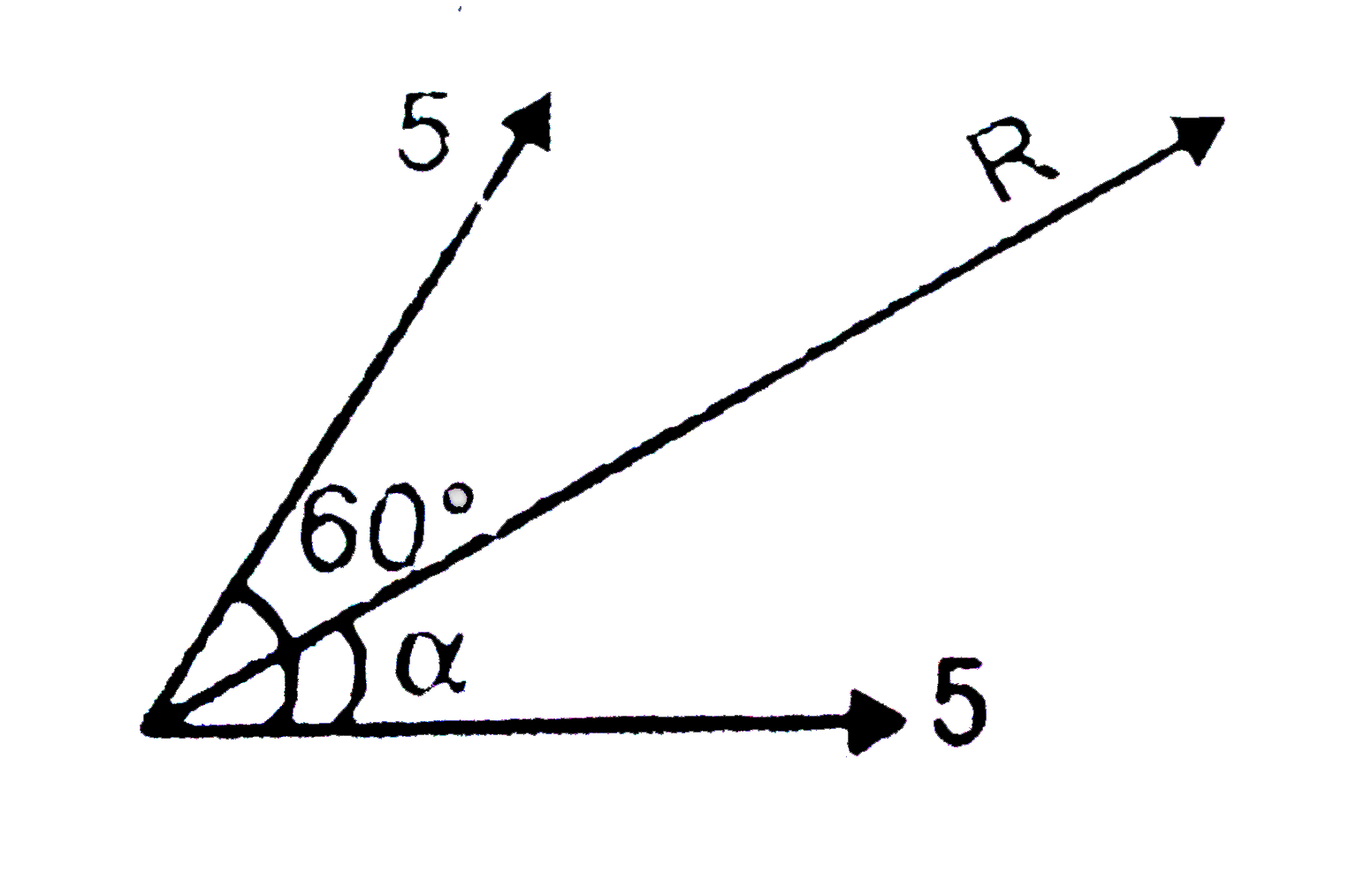Two vectors having magnitude 12 and 13 are inclined at and angle45∘ to each other.find their resultant vector.
The correct Answer is:23.09 at 21.55∘ with vector of magnitude 13.
To find the resultant vector of two vectors with magnitudes 12 and 13 inclined at an angle of 45 degrees to each other, we can follow these steps:
Step 1: Identify the vectors and their magnitudes
Let vector A have a magnitude of 12 and vector B have a magnitude of 13. The angle (θ) between them is 45 degrees.
Step 2: Use the formula for the magnitude of the resultant vector
The magnitude of the resultant vector (C) can be calculated using the formula:
|C|=√A2+B2+2ABcos(θ)
Substituting the values:
|C|=√122+132+2⋅12⋅13⋅cos(45∘)
Step 3: Calculate the squares of the magnitudes
Calculate 122 and 132:
122=144
132=169
Step 4: Calculate 2ABcos(θ)
First, calculate 2⋅12⋅13:
2⋅12⋅13=312
Now, calculate cos(45∘):
cos(45∘)=1√2≈0.7071
Now multiply:
312⋅cos(45∘)≈312⋅0.7071≈220.88
Step 5: Substitute back into the formula
Now substitute these values back into the formula for the magnitude of C:
|C|=√144+169+220.88
Calculating the sum:
|C|=√533.88
Step 6: Calculate the square root
Now, find the square root:
|C|≈23.09
Step 7: Calculate the angle α with respect to vector B
To find the angle α that the resultant vector makes with vector B, we can use the formula:
α=tan−1(Asin(θ)B+Acos(θ))
Substituting the known values:
α=tan−1(12⋅sin(45∘)13+12⋅cos(45∘))
Step 8: Calculate sin(45∘) and cos(45∘)
We already know:
sin(45∘)=1√2≈0.7071
Substituting this value:
α=tan−1(12⋅0.707113+12⋅0.7071)
Step 9: Calculate the numerator and denominator
Numerator:
12⋅0.7071≈8.49
Denominator:
13+12⋅0.7071≈13+8.49≈21.49
Step 10: Calculate α
Now substitute these into the formula:
α=tan−1(8.4921.49)
Calculating the value:
α≈tan−1(0.394)≈21.55∘
Final Result
The magnitude of the resultant vector is approximately 23.09 and the angle with vector B is approximately 21.55 degrees.
---
Let vector A have a magnitude of 12 and vector B have a magnitude of 13. The angle (θ) between them is 45 degrees.
The magnitude of the resultant vector (C) can be calculated using the formula:
|C|=√A2+B2+2ABcos(θ)
Substituting the values:
|C|=√122+132+2⋅12⋅13⋅cos(45∘)
Calculate 122 and 132:
122=144
132=169
First, calculate 2⋅12⋅13:
2⋅12⋅13=312
Now, calculate cos(45∘):
cos(45∘)=1√2≈0.7071
Now multiply:
312⋅cos(45∘)≈312⋅0.7071≈220.88
Now substitute these values back into the formula for the magnitude of C:
|C|=√144+169+220.88
Calculating the sum:
|C|=√533.88
Now, find the square root:
|C|≈23.09
To find the angle α that the resultant vector makes with vector B, we can use the formula:
α=tan−1(Asin(θ)B+Acos(θ))
Substituting the known values:
α=tan−1(12⋅sin(45∘)13+12⋅cos(45∘))
We already know:
sin(45∘)=1√2≈0.7071
Substituting this value:
α=tan−1(12⋅0.707113+12⋅0.7071)
Numerator:
12⋅0.7071≈8.49
Denominator:
13+12⋅0.7071≈13+8.49≈21.49
Now substitute these into the formula:
α=tan−1(8.4921.49)
Calculating the value:
α≈tan−1(0.394)≈21.55∘
The magnitude of the resultant vector is approximately 23.09 and the angle with vector B is approximately 21.55 degrees.
Topper's Solved these Questions
- MOTION IN A PLANEBOOK - AAKASH INSTITUTE ENGLISHCHAPTER - MOTION IN A PLANEEXERCISE - Assignement section -A Objective (one option is correct)
50 Videos
- MOTION IN A PLANEBOOK - AAKASH INSTITUTE ENGLISHCHAPTER - MOTION IN A PLANEEXERCISE - Assignement section -B Objective (one option is correct)
29 Videos
- MOTION IN A PLANEBOOK - AAKASH INSTITUTE ENGLISHCHAPTER - MOTION IN A PLANEEXERCISE - llustration 1 :
1 Videos
- MOCK_TEST_17BOOK - AAKASH INSTITUTE ENGLISHCHAPTER - MOCK_TEST_17EXERCISE - Example
15 Videos
- MOTION IN A STRAIGHT LINEBOOK - AAKASH INSTITUTE ENGLISHCHAPTER - MOTION IN A STRAIGHT LINEEXERCISE - ASSIGNMENT (SECTION - D)
15 Videos
Similar Questions
When two vectors of magnitudes P and Q are inclined at an angle θ, the magnitudes of their resultant is 2P. When the inclination is changed to 180∘−θ, the magnitudes of the resultant is halved. Find the ratio of P and Q.
View SolutionTwo vectors having equal magnitudes A make an angle θ with each other. Find the magnitude and direction of the resultant.
View SolutionThe resultant of two vectors , having equal magnitudes E make an angle of 120∘ with each other . What is the magnitude and direction of the resultant ?
View SolutionIf three unit vectors are inclined at an angle of 60∘ with each other, then the magnitude of their resultant vector will be
View SolutionTwo unequal vectors are inclined at an angle 30∘. When they are added, the resultant can be :
View SolutionTwo vectors having equal magnitudes A make an angle θ with eahc other. Find the magnitude and direction of the resultant.
View SolutionTwo vectors having equal magnitude of 5 units, have an angle of 60∘ between them. Find the magnitude of their resultant vector and its angle from one of the vectors.

View SolutionTwo vectors of equal magnitude P are inclined at some angle such that the difference in magnitude of resultant and magnitude of either of the vectors is 0.732 times either of the magnitude of vectors. If the angle between them is increased by half of its initial value then find the magnitude of difference of the vectors
View SolutionTwo vectors →Pand→Q are inclined to each other at angle θ. Which of the following is the unit vector perpendicular to →Pand→Q ?
View SolutionTwo vectors →a and →b are at an angle of 60∘ with each other . Their resultant makes an angle of 45∘ with →a If ∣∣→b∣∣=2unit , then |→a| is
View Solution
